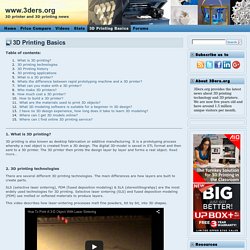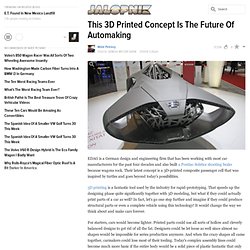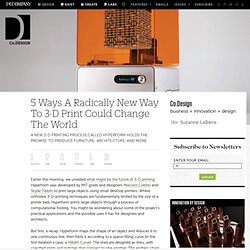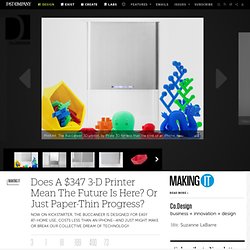

3D printed bump keys make short work of high-security locks. High-end locks rely on their unique key-shapes to prevent "bumping" (opening a lock by inserting a key-blank and hitting it with a hammer, causing the pins to fly up), but you can make a template for a bump key by photographing the keyhole and modelling it in software.

Jos Weyers and Christian Holler presented their work on 3D printed bump keys at NYC's Hackers on Planet Earth last month, as an existence proof of the insufficiency of relying on proprietary shapes to defend a lock. The locks they attacked were successfully opened with keys printed in nylon, of the sort you can order from service bureaux like I.Materialize and Shapeways.
Eggbot Pro: an all-metal plotter for drawing on curved surfaces. Evil Mad Scientist Labs have updated their beloved open-source hardware Eggbot, a plotter that draws on curved surfaces, with a new all-metal model called the Eggbot Pro.

The standard pen holder included with the EggBot kit is designed to fit various art pens including Sharpie Ultra Fine Point and Sharpie Fine Point pens. However, it can actually fit almost any pen of similar size. You can even fit a lot of things that aren't pens. One example: We offer a diamond point engraving tool for EggBot (shown here), capable of etching and engraving hard materials like glass, stone, and ceramic. And, if decorating eggs is your focus, check out our Electro-Kistka attachment, capable of painting wax onto eggs for traditional wax-resist and dye (batik) processes. Introducing the EggBot Pro Cory Doctorow at 8:00 pm Tue, Aug 26, 2014 Cory Doctorow at 6:57 pm Tue, Aug 26, 2014.
Blobless Printing With Velocity Extrusion. Replicator 1 Receives a PID Controlled Heated Chamber. Royalty Free License : TurboSquid Help & Support. 3D Printing Basics. Table of contents: 1.

Preparing a Model for 3D Printing. Updated March 30, 2016.

Since you're here reading this, we assume you're interested in having one of your 3D models transformed into a real world object. We don't blame you! 3D printing is an incredibly exciting technology, and getting to hold one of your digital creations in the palm of your hand is an absolutely fantastic feeling. Filament Extruder Pumps Out 1kg/hour! Filament Extruder Pumps Out 1kg/hour! Make a 3D Scanner for 60€ Using Old Hardware.
Automated Bed Leveling For 3D Printers Is Now Solved. Build Your Own Arduino-Powered Laser Cutter. Recycling Plastic With Liquid Nitrogen. The Quick Guide to Buying a 3D Printer. Ripper – build log overview. This 3D Printed Concept Is The Future Of Automaking. Someone call me when you can 3D print non-isotropic structural materials.

Until then, every story like this heralding 3D printing as taking over all other forms of manufacturing gets rubber-stamped as "written by a layman" in my book. I design highly loaded structural parts all day long. 3D printing is about as useful in creating an analogue to an anisotropic composite laminate or forged metallic part as a screen door on a submarine. Doesn't Boeing use a CNC carbon fiber machine to build fuselages? I agree with you about materials being 3D printed. It's impossible with current tech to print a strong load bearing structures. It's coming. We have been using CNC composite tape laying machines you are describing since the early 1980s in my industry and at my company.
Scanners. Cutters. Printers. Applications. Metal Printing. SainSmart PLA-157 PLA Filament (Black): Car Electronics. How to design and inset magnets INSIDE your 3D prints! Incorporating Screw Threads into Fused Deposition Modeling Parts. 3D Printers, 3D Printing, 3D Parts and Rapid Prototyping.
Adgaudio/3dPrinter. Robocut studio Digital fabrication for creatives. These genetically-modified bees make concrete instead of honey. I gots me a 3D printer!! 5 Ways A Radically New Way To 3-D Print Could Change The World. Earlier this morning, we unveiled what might be the future of 3-D printing.

Hyperform was developed by MIT grads and designers Marcelo Coelho and Skylar Tibbits to print large objects using small desktop printers. Where orthodox 3-D-printing techniques are fundamentally limited by the size of a printer bed, Hyperform prints large objects through a process of computational folding. You might be wondering about some of the project’s practical applications and the possible uses it has for designers and architects. But first, a recap: Hyperform maps the shape of an object and reduces it to one continuous line, then folds it according to a space-filling curve (in the first iteration’s case, a Hilbert Curve).
The lines are designed as links, with specified joints and notches that connect to one another. “The game you’re playing is what is the longest possible curve you can fit in the smallest possible volume,” Tibbits explains, referring to the system’s most consequential step. 1. 2. 3. 4. MIT Researchers Unveil A New, Smarter Way To 3-D Print. 3-D printing has become the rallying cause for a rising generation of designers, engineers, and architects.

There seems to be few limits to what the technology can do or what range of products it can spawn, from lampshades to lunar bases. Amid all the hype, however, it’s easy to neglect one key factor: Printing capabilities are directly wedded to the size of one’s printer. As home printers become more readily available, the size of their printing beds shrink. 3D Printing. MIT Students Release Program To 3D-Print High Security Keys. NYU Offering 3D Printing Course to the Public. New York University is offering an intensive three-week class in 3D printing that aims to teach not only the basics of 3D printing, but also how to navigate the often complex field of different printer capabilities, materials, design software and more. 3D printers have been around since the 1980s.

In the past few years, however, 3D printing has become a pop culture buzzword and more: NASA has used 3D-printing methods to build spacecraft parts, and biologists recently succeeded in creating the first 3D-printed ear. As the technology becomes more affordable, more small businesses and artists are incorporating it into their process. This NYU course, entitled "3D Printing: Rapid Prototyping Intensive," is aimed at bringing the technical skill associated with 3D printing to a broad swath of people, from digital artists to entrepreneurs to hobbyists. The professors say the course isn't just about the mechanics of 3D printing.
3D printing for all: Inside Chicago library’s new “pop-up maker lab” CHICAGO, IL — If you've ever had a hankering to try out a 3D printer, a laser cutter, or a milling machine without dropping thousands of your own hard-earned dollars, the Harold Washington Library in Chicago is the place to be.

Starting today, July 8, Harold Washington has become the first major urban library to open a pop-up "maker lab," allowing members of the general public the opportunity to experiment with the cutting-edge technologies. And while there are still a few wrinkles to iron out before the public can use all the machines, the Chicago Public Library (CPL) system is already looking forward to where this project will go next. "There's more buzz about this on social media than anything we've ever done," CPL's First Deputy Commissioner Andrea Sáenz told Ars. What exactly is the pop-up maker lab? CPL partnered up with Chicago's Museum of Science and Industry—which is offering its own maker lab to museum visitors—in order to put together the program. Does A $347 3-D Printer Mean The Future Is Here? Or Just Paper-Thin Progress?
The magic words, or magic number-plus-letter, of our technological fantasies to date are: 3-D.

The 3-D printer is this year’s collective culmination of a dream, the invention that gets us all starry-eyed, the latest in a long history of devices--from the jet-pack to the robot who does our housework to the spy watch--that we want so deeply to deliver, to elevate our analog human existence, that we tend to lose any logical capacity to assess it.
Now, say not just 3-D Printer, but 3-D Printer for $347--as the Buccaneer, a Kickstarter project launched by Pirate 3D, promises--and not surprisingly, funding follows fantasy. It raised more than $1.4 million (ten times the original goal) and the first units are expected out in early 2014, when it will be by far the cheapest option on the market (RepRap’s printer follows second, at around $500 unless you buy it disassembled). Likewise, Pirate 3D plans to develop an open source model through its own store, dubbed Treasure Island. Innovations - Tesco va t-il démocratiser l'impression 3D dans les magasins ? Publié le 07 juillet 2013. Microsoft Makes 3-D Printing As Simple As Clicking "Print" To be honest, 3-D printing technology just isn’t there yet for consumers.
It’s expensive. It’s relatively lousy. And it takes a slew of skills--from technical to artistic--to produce anything worth printing in the first place. So specialists, like designers and engineers, can enjoy its rapid fabrication, and everyone else is left behind. Today, Microsoft announced a crucial step to empower the next wave of 3-D printer adoption. And that’s really the appeal of Microsoft’s pitch. Old-school 3D printing firm buys a hot little startup, MakerBot, for $403M. 3D Printing and the Future of Stuff. Un concours de conception de moteur de fusée imprimé en 3D. L'impression 3D est au centre de toutes les attentions ces derniers mois. Pressentie comme une véritable petite révolution industrielle à elle seule, elle semble pouvoir tout réaliser ou presque.
Un nouveau procédé de lissage révolutionne l'impression 3D. Austin Wilson et Neil Underwood de Caroline du Nord ont inventé un nouveau procédé permettant de totalement lisser les impressions en 3D en utilisant de l'acétone. Ce processus, en plus de l’obtention d’une finition d’excellente facture, permet également de contourner tout un tas de complexes brevets propres au polissage. La technique reste perfectible et demande encore quelques modifications mineures. L’annonce a été faite à cause (grâce) du résultat impressionnant qui en découle, l’excitation en somme. Et on comprend pourquoi, les images parlent d’elles-mêmes, voyez. L'imprimante 3D dans une ligne de production.
L'imprimante 3D est décidément un objet phare de ces dernières années et de celles à venir. Malheureusement, elles sont limitées à de "simples" objets, des objets faits d'une seule pièce tout du moins. Pourtant, un brevet déposé par iRobot pourrait bien placer l'imprimante 3D au sein d'une véritable petite ligne de production. Découvert par 3ders, ce brevet date de Juin. iRobot, le fabricant du désormais célébrissime Roomba, a ainsi envisagé de permettre à son imprimante 3D d’assembler différentes pièces. Ars Technicast, Episode 27: Will the revolution be 3D-printed? How to Make a Record Out of Wood. Amanda Ghassaei, the woman who brought you 3D-printed records , is back with yet another impressive alternative to vinyl: laser-cut maple and plywood.
And not only do the wooden records look real pretty, they sound a hell of a lot better than their printed-plastic counterparts. But wood is still nowhere near bona fide vinyl, unfortunately. With a sample rate of just 4.5 kHz and a bit depth between four and five, the sound quality is still in the relative stone ages, with most high frequency sounds rolled off and limited dynamic range (digital audio typically ranges from 44.1-96 kHz and 16-32 bits, for comparison). 3D-Printed Records Are IRL Versions of MP3s. Using a highly advanced 3D printer with a resolution of 600 dpi, Instructables’ assistant tech editor Amanda Ghassaei creates the world’s first 3D-printed records.
By layering finely printed plastic no more than 16 microns thick, Ghassaei creates the same characteristic grooves a realy vinyl would have. In her Instructables post she provides all the technical mumbo jumbo for any nerds that want to try this at home. According to Ghassaei the tracks have a sampling rate of “11kHz (only a quarter of typical mp3 audio) and 5-6 bit resolution (mp3 audio is 16-bit)”. The records can even be played using a standard needle, and although they sound absolutely awful, the concept is still pretty cool. Ghassaei’s first experiment?
Curious about the making of the record?